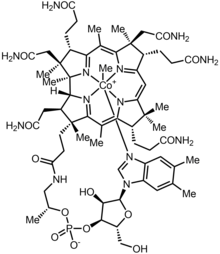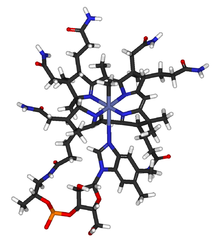Methylcobalamin
 | |
 | |
| Clinical data | |
|---|---|
| Trade names | Cobolmin |
| AHFS/Drugs.com | International Drug Names |
| Routes of administration | By mouth,sublingual, injection. |
| ATC code | |
| Legal status | |
| Legal status |
|
| Identifiers | |
| |
| CAS Number | |
| PubChemCID | |
| ChemSpider | |
| UNII | |
| ChEMBL | |
| CompTox Dashboard(EPA) | |
| ECHA InfoCard | 100.033.200 |
| Chemical and physical data | |
| Formula | C63H91CoN13O14P |
| Molar mass | 1344.405g·mol−1 |
| 3D model (JSmol) | |
| |
| |
Methylcobalamin(mecobalamin, MeCbl, or MeB12) is acobalamin,a form ofvitamin B12.It differs fromcyanocobalaminin that thecyano groupat the cobalt is replaced with amethyl group.[1]Methylcobalamin features an octahedral cobalt(III) centre and can be obtained as bright red crystals.[2]From the perspective ofcoordination chemistry,methylcobalamin is notable as a rare example of a compound that contains metal–alkyl bonds.Nickel–methyl intermediates have been proposed for the final step ofmethanogenesis.
Methylcobalamin is equivalent physiologically to vitamin B12,[3]and can be used to prevent or treat pathology arising from a lack of vitamin B12intake (vitamin B12deficiency).
Methylcobalamin is also used in the treatment ofperipheral neuropathy,diabetic neuropathy,and as a preliminary treatment foramyotrophic lateral sclerosis.[4]
Methylcobalamin that is ingested is not used directly as a cofactor, but is first converted byMMACHCinto cob(II)alamin. Cob(II)alamin is then later converted into the other two forms, adenosylcobalamin and methylcobalamin for use as cofactors. That is, methylcobalamin is first dealkylated and then regenerated.[5][6][7]
According to one author, it is important to treatvitamin B12deficiency withhydroxocobalaminorcyanocobalaminor a combination ofadenosylcobalaminand methylcobalamin, and not methylcobalamin alone.[8]
Production[edit]

Methylcobalamin can be produced in the laboratory by reducingcyanocobalaminwithsodium borohydridein alkaline solution, followed by the addition ofmethyl iodide.[2]
Functions[edit]
Thisvitamer,along withadenosylcobalamin,is one of two active coenzymes used by vitamin B12-dependent enzymes and is the specific vitamin B12form used by5-methyltetrahydrofolate-homocysteine methyltransferase(MTR), also known as methionine synthase.[citation needed]
Methylcobalamin participates in theWood-Ljungdahl pathway,which is a pathway by which some organisms utilize carbon dioxide as their source of organic compounds. In this pathway, methylcobalamin provides the methyl group that couples to carbon monoxide (derived from CO2) to affordacetyl-CoA.Acetyl-CoA is a derivative of acetic acid that is converted to more complex molecules as required by the organism.[9]
Methylcobalamin is produced by somebacteria.[citation needed]It plays an important role in the environment, where it is responsible for thebiomethylationof certainheavy metals.For example, the highly toxicmethylmercuryis produced by the action of methylcobalamin.[10]In this role, methylcobalamin serves as a source of "CH3+".
A lack of cobalamin can lead tomegaloblastic anemiaand subacute combined degeneration of the spinal cord.[11]
See also[edit]
References[edit]
- ^McDowell LR (2000).Vitamins in animal and human nutrition.Wiley.ISBN978-0813826301.Retrieved28 January2018– via Booksgoogle.com.
- ^abDavid D (January 1971). "Preparation of the Reduced Forms of Vitamin B12and of Some Analogs of the Vitamin B12Coenzyme Containing a Cobalt-Carbon Bond ". In McCormick DB, Wright LD (eds.).Vitamins and Coenzymes.Methods in Enzymology. Vol. 18. Academic Press. pp. 34–54.doi:10.1016/S0076-6879(71)18006-8.ISBN9780121818821.
- ^Sil A, Kumar H, Mondal RD, Anand SS, Ghosal A, Datta A, Sawant SV, Kapatkar V, Kadhe G, Rao S (July 2018)."A randomized, open labeled study comparing the serum levels of cobalamin after three doses of 500 mcg vs. a single dose methylcobalamin of 1500 mcg in patients with peripheral neuropathy".The Korean Journal of Pain.31(3): 183–190.doi:10.3344/kjp.2018.31.3.183.PMC6037815.PMID30013732.
- ^"Eisai Submits New Drug Application for Mecobalamin Ultra-High Dose Preparation as Treatment for Amyotrophic Lateral Sclerosis in Japan"(PDF).Eisai.com.Retrieved28 January2018.
- ^Kim J, Hannibal L, Gherasim C, Jacobsen DW, Banerjee R (November 2009)."A human vitamin B12 trafficking protein uses glutathione transferase activity for processing alkylcobalamins".The Journal of Biological Chemistry.284(48): 33418–33424.doi:10.1074/jbc.M109.057877.PMC2785186.PMID19801555.
- ^Hannibal L, Kim J, Brasch NE, Wang S, Rosenblatt DS, Banerjee R, Jacobsen DW (August 2009)."Processing of alkylcobalamins in mammalian cells: A role for the MMACHC (cblC) gene product".Molecular Genetics and Metabolism.97(4): 260–266.doi:10.1016/j.ymgme.2009.04.005.PMC2709701.PMID19447654.
- ^Froese DS, Gravel RA (November 2010)."Genetic disorders of vitamin B₁₂ metabolism: eight complementation groups–eight genes".Expert Reviews in Molecular Medicine.12:e37.doi:10.1017/S1462399410001651.PMC2995210.PMID21114891.
- ^Thakkar K, Billa G (January 2015)."Treatment of vitamin B12 deficiency – Methylcobalamine? Cyancobalamine? Hydroxocobalamin? – clearing the confusion".European Journal of Clinical Nutrition.69(1): 1–2.doi:10.1038/ejcn.2014.165.PMID25117994.
- ^Fontecilla-Camps JC, Amara P, Cavazza C, Nicolet Y, Volbeda A (August 2009). "Structure-function relationships of anaerobic gas-processing metalloenzymes".Nature.460(7257): 814–822.Bibcode:2009Natur.460..814F.doi:10.1038/nature08299.PMID19675641.S2CID4421420.
- ^Schneider Z, Stroiński A (1987),Comprehensive B12: Chemistry, Biochemistry, Nutrition, Ecology, Medicine,Walter de Gruyter,ISBN978-3110082395
- ^Bémeur C, Montgomery JA, Butterworth RF (2011). "Vitamins Deficiencies and Brain Function". In Blass JP (ed.).Neurochemical Mechanisms in Disease.Advances in Neurobiology. Vol. 1. pp. 103-124 (112).doi:10.1007/978-1-4419-7104-3_4.ISBN978-1-4419-7103-6.
